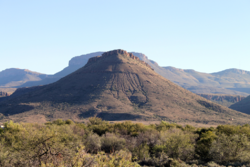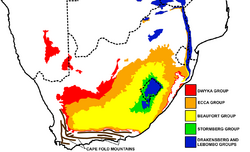Earth:Teekloof Formation
| Teekloof Formation Stratigraphic range: Middle Permian ~265–255 Ma | |
|---|---|
 | |
| Type | Geological formation |
| Unit of | Adelaide Subgroup, Beaufort Group |
| Overlies | Abrahamskraal Formation |
| Thickness | up to 300 m (980 ft) |
| Lithology | |
| Primary | Mudstone, siltstone |
| Other | Sandstone |
| Location | |
| Coordinates | [ ⚑ ] : 32°56′56″S 25°48′58″E / 32.949°S 25.816°E |
| Region | Western, Northern & Eastern Cape |
| Country | |
| Type section | |
| Named for | Teekloof Pass |
 | |
The Teekloof Formation is a geological formation that forms part of the Beaufort Group, one of the five geological groups that comprises the Karoo Supergroup in South Africa . The Teekloof Formation is the uppermost formation of Adelaide Subgroup deposits West of 24ºE and contains Middle to Late Permian-aged (Guadalupian to Lopingian) deposits and four biozones (Pristerognathus, Tropidostoma, Cistecephalus, and Daptocephalus assemblage zones) of the Beaufort Group.[1][2] It overlies the Abrahamskraal Formation (the western correlate of the Middleton Formation). The Teekloof Formation does not underlie other units other than the younger Karoo dolerites and sills that relate to the emplacement of the Early Jurassic Drakensberg Group to the east.[3] Outcrops and exposures of the Teekloof Formation range from Sutherland through the mountain escarpments between Fraserburg and Beaufort West. The northernmost localities of the Teekloof Formation are found by Loxton, Victoria West and Richmond.[4]
Geology
The Teekloof Formation overlies the Abrahamskraal Formation and is not capped by any other preserved sedimentation. Only East of 24ºE does the preservation of Beaufort Group rocks continue. There is no rock preservation in the western-southwestern portions of the Karoo Basin.[5][6][7] It is unclear whether rock preservation there ceased in the Late Permian due to localized basinal tectonics, or if that rock material was preserved but later weathered away.[8] The Teekloof Formation has five subdivisions or members which are listed below (from oldest to youngest):
- Poortjie Member - Correlates with the Pristerognathus Assemblage Zone
- Hoedemaker Member - Correlates with the Tropidostoma Assemblage Zone
- Oukloof Member - Correlates with the Cistecephalus Assemblage Zone
- Steenkampsvlakte Member - Correlates with the Daptocephalus Assemblage Zone
- Javanerskop Member - Correlates with the Daptocephalus Assemblage Zone
Lithologies
The sedimentary rocks of this formation are predominantly reddish or minor green mudstones that are either structureless, horizontally laminated, or medium to thickly bedded. Pedogenic and diagenetic carbonate nodules and also fossil gypsum rosettes occur in the mudstone deposits. Interbedded with the mudstone deposits are minor channel sandstones ranging from pale olive to greenish-grey in colour. The sandstones are fine to medium grained and preserve fining-upward sequences (e.g. from bottom to top: Massive, horizontally laminated, trough cross-bedded, and ripple cross-laminated sedimentary structures). In the uppermost sections of the Teekloof Formation, the Javanerskop Member contains ribbon-shaped, single storied sandstones. These sandstones in the uppermost sections contain numerous erosional surfaces lined with siltstone or mudstone pellet conglomerates.[9][10]
Geologists consider the Teekloof Formation depositional environment to have been a floodplain facies association that underwent seasonal arid conditions and playa lake formation as indicated by the presence of fossil gypsum rosettes and carbonate nodules. The sandstone occurrences preserve evidence of deposition on point bars in a meandering river system. Seasonal waning flood level events are indicated by the fining upward sequences.[11]
Paleontology
The Teekloof Formation is rich in fossil material and is particularly renowned for its diverse therapsid fossil fauna. Plant and invertebrate trace fossils are also found as are some preserved vertebrate fossil trackways. Well-known trackways of the pareiasaur Bradysaurus, and therapsids Diictodon and Tapinocaninus have been found by the town Fraserburg.[12][13][14][15][16][17][18]
References
- ↑ Keyser, A. W., and Smith, R. M. H. (1978). Vertebrate biozonation of the Beaufort Group with special reference to the western Karoo Basin. Geological Survey, Department of Mineral And Energy Affairs, Republic of South Africa.
- ↑ Keyser, A. W. (1979). A review of the biostratigraphy of the Beaufort Group in the Karoo Basin of South Africa. Geocongress, Geological Society of South Africa, 2, 13-31.
- ↑ Kitching, J. W. (1970). A short review of the Beaufort zoning in South Africa. In Second Gondwana Symposium Proceedings and Papers (Vol. 1, pp. 309-312).
- ↑ Rubidge, B. S. (ed.) 1995b. Biostratigraphy of the Beaufort Group (Karoo Supergroup). South African Committee of Stratigraphy. Biostratigraphic Series 1. Pretoria, Council for Geoscience.
- ↑ Day, Mike (2013-12-18). "Charting the fossils of the Great Karoo: a history of tetrapod biostratigraphy in the Lower Beaufort Group, South Africa" (in en). Palaeontologia Africana. ISSN 0078-8554. http://wiredspace.wits.ac.za/handle/10539/13308.
- ↑ Day, Michael Oliver (2014-03-04). Middle Permian continental biodiversity changes as reflected in the Beaufort Group of South Africa: a bio-and lithostratigraphic review of the Eodicynodon, Tapinocephalus and Pristerognathus assemblage zones (PhD thesis).
- ↑ Viglietti, Pia A.; Smith, Roger M.H.; Rubidge, Bruce S. (2018). "Changing palaeoenvironments and tetrapod populations in the Daptocephalus Assemblage Zone (Karoo Basin, South Africa) indicate early onset of the Permo-Triassic mass extinction". Journal of African Earth Sciences 138: 102–111. doi:10.1016/j.jafrearsci.2017.11.010. Bibcode: 2018JAfES.138..102V.
- ↑ Catuneanu; Hancox; Rubidge (1998). "Reciprocal flexural behaviour and contrasting stratigraphies: A new basin development model for the Karoo retroarc foreland system, South Africa". Basin Research 10 (4): 417–439. doi:10.1046/j.1365-2117.1998.00078.x. Bibcode: 1998BasR...10..417C.
- ↑ Smith, Roger M. H. (1990-03-01). "Alluvial Paleosols and pedofacies sequences in the Permian Lower Beaufort of the southwestern Karoo Basin, South Africa" (in en). Journal of Sedimentary Research 60 (2): 258–276. doi:10.1306/212F916A-2B24-11D7-8648000102C1865D. ISSN 1527-1404. https://pubs.geoscienceworld.org/sepm/jsedres/article-abstract/60/2/258/113829/alluvial-paleosols-and-pedofacies-sequences-in-the.
- ↑ Smith, R. M. H.; Rubidge, B. S.; Viglietti, P. A. (2017-03-01). "Revised lithostratigraphy of the Upper Permian Balfour and Teekloof formations of the main Karoo Basin, South Africa" (in en). South African Journal of Geology 120 (1): 45–60. doi:10.25131/gssajg.120.1.45. ISSN 1012-0750. Bibcode: 2017SAJG..120...45V.
- ↑ Smith, Roger M. H. (1989). Fluvial facies, vertebrate taphonomy and palaeosols of the Teekloof formation (Permian) near Beaufort West, Cape Province, South Africa. https://open.uct.ac.za/handle/11427/23646.
- ↑ Damiani, Ross J. (2004). "Temnospondyls from the Beaufort Group (Karoo Basin) of South Africa and Their Biostratigraphy". Gondwana Research 7 (1): 165–173. doi:10.1016/S1342-937X(05)70315-4. Bibcode: 2004GondR...7..165D.
- ↑ Sidor, Christian A.; Hopson, James A.; Keyser, André W. (2004). "A new burnetiamorph therapsid from the Teekloof Formation, Permian, of South Africa". Journal of Vertebrate Paleontology 24 (4): 938–950. doi:10.1671/0272-4634(2004)024[0938:ANBTFT2.0.CO;2].
- ↑ Sidor, Christian A.; Smith, Roger M. H. (2007). "A second burnetiamorph therapsid from the Permian Teekloof Formation of South Africa and its associated fauna". Journal of Vertebrate Paleontology 27 (2): 420–430. doi:10.1671/0272-4634(2007)27[420:ASBTFT2.0.CO;2].
- ↑ Rubidge, Bruce S. (1990). "A new vertebrate biozone at the base of the Beaufort Group, Karoo sequence (South Africa)" (in en). Palaeontologia Africana. ISSN 0078-8554. http://wiredspace.wits.ac.za/handle/10539/16155.
- ↑ Klerk, De; J, William (2002). "A dicynodont trackway from the Cistecephalus Assemblage Zone in the Karoo, East of Graaff-Reinet, South Africa" (in en). Palaeontologia Africana. ISSN 0078-8554. http://wiredspace.wits.ac.za/handle/10539/16345.
- ↑ Smith, Roger M. H.; Kammerer, Christian F. (2017-01-31). "An early geikiid dicynodont from the Tropidostoma Assemblage Zone (late Permian) of South Africa" (in en). PeerJ 5: e2913. doi:10.7717/peerj.2913. ISSN 2167-8359. PMID 28168104.
- ↑ Lucas, Spencer G.; Voigt, Sebastian (2018-01-01). "Outline of a Permian tetrapod footprint ichnostratigraphy" (in en). Geological Society, London, Special Publications 450 (1): 387–404. doi:10.1144/SP450.10. ISSN 0305-8719. Bibcode: 2018GSLSP.450..387V. http://sp.lyellcollection.org/content/450/1/387.
 |

